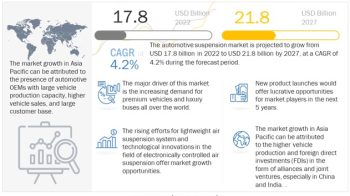
The water & wastewater treatment equipment market is projected to reach USD 87.7 billion by 2029, at a CAGR of 5.0% from USD 68.7 billion in 2024. The water and wastewater treatment equipment market encompasses a wide range of technologies and solutions aimed at purifying and managing water resources. This market includes equipment such as filters, pumps, disinfection systems, membranes, and clarifiers, among others. Key drivers for this market include increasing water scarcity, growing awareness about water quality and environmental concerns, and stringent regulations on wastewater discharge. The market is also influenced by trends such as the adoption of advanced technologies like membrane filtration and UV disinfection, as well as the focus on sustainable water management practices. Major players in this market compete through product innovation, strategic partnerships, and geographic expansion to cater to the diverse needs of industries, municipalities, and commercial sectors globally.
Download PDF Brochure at https://www.marketsandmarkets.com/pdfdownloadNew.asp?id=948
Based on Product Type, the water and wastewater treatment equipment market has been segmented into filtration, disinfection, desalination, sludge treatment, biological, testing and others. Filtration accounted for the largest share, in terms of value, of the global market in 2024.
The filtration segment is the largest in the water and wastewater treatment equipment market due to several key factors. Firstly, filtration is a fundamental and essential step in water treatment processes, regardless of the source or type of water being treated. Filtration systems effectively remove suspended solids, contaminants, and impurities, improving water quality and making it suitable for various applications such as drinking water supply, industrial processes, and agricultural use. Secondly, with increasing concerns about water pollution and the need for clean water globally, there is a growing demand for reliable and efficient filtration solutions. This demand is particularly pronounced in rapidly developing regions where water quality issues are more prevalent. Additionally, advancements in filtration technologies, such as membrane filtration and ultrafiltration, have enhanced the effectiveness and versatility of filtration systems, further driving market growth. Furthermore, stringent regulatory standards and environmental regulations mandating the use of effective filtration systems in wastewater treatment plants and industrial facilities contribute to the segment’s dominance. Overall, the filtration segment’s size and growth in the water and wastewater treatment equipment market are a result of its critical role, technological advancements, increasing water quality concerns, and regulatory requirements.
Request For FREE Sample of Report at https://www.marketsandmarkets.com/requestsampleNew.asp?id=948
Based on Process, the water andwastewater treatment equipment market has been segmented into primary, secondary and tertiary. Tertiary process accounted for the largest share, in terms of value, of the global market in 2024.
The tertiary process segment is the largest in the water and wastewater treatment equipment market for several compelling reasons. Firstly, the tertiary treatment process plays a crucial role in achieving the highest level of water quality standards, especially for wastewater treatment plants aiming to meet strict regulatory requirements. This process involves advanced treatment methods such as filtration, disinfection, and nutrient removal, which are essential for removing remaining contaminants and pathogens from treated water before its release into the environment or reuse in various applications. Secondly, as global water scarcity and pollution concerns intensify, there is a growing emphasis on recycling and reusing wastewater, driving the demand for sophisticated tertiary treatment equipment and technologies. These systems ensure that treated wastewater meets quality standards for safe reuse in irrigation, industrial processes, and even potable water applications in some cases. Additionally, technological advancements in tertiary treatment processes, such as the use of membrane filtration, UV disinfection, and advanced oxidation, have improved treatment efficiency, reduced operating costs, and expanded the applicability of tertiary treatment solutions across different industries and municipalities. Moreover, increasing awareness about the environmental impact of untreated or poorly treated wastewater further fuels the adoption of robust tertiary treatment equipment, making it the largest segment in the water and wastewater treatment market.
Based on End-user, the water andwastewater treatment equipment market has been segmented into municipal and industrial. Municipal segment accounted for the largest share, in terms of value, of the global market in 2024.
The municipal segment is the largest in the water and wastewater treatment equipment market due to several critical factors. Firstly, municipalities are responsible for providing safe and clean drinking water to their residents and managing wastewater from households, commercial establishments, and public facilities. This creates a substantial and continuous demand for water and wastewater treatment equipment and solutions. Secondly, rapid urbanization and population growth in urban areas have led to increased pressure on municipal water infrastructure, necessitating upgrades and expansions of treatment facilities and processes. Moreover, stringent regulatory standards and guidelines for water quality and environmental protection mandate municipalities to invest in advanced treatment technologies and equipment to ensure compliance and safeguard public health. Additionally, government initiatives and funding programs aimed at improving water infrastructure, particularly in developing regions, drive investments in municipal water and wastewater treatment projects. Furthermore, rising awareness among communities about the importance of clean water and sustainable water management practices encourages municipalities to adopt innovative and efficient treatment solutions. Overall, these factors contribute to the dominance of the municipal segment in the water and wastewater treatment equipment market globally.
Asia Pacific is the largest region for the water and wastewater treatment equipment market due to several key factors. Firstly, rapid industrialization and urbanization in countries like China, India, and Southeast Asian nations have led to increased water pollution and scarcity, driving the demand for advanced treatment solutions. The region’s expanding population and economic growth have further intensified the need for clean water for domestic, industrial, and agricultural purposes. Secondly, stringent environmental regulations and policies aimed at mitigating water pollution and improving water quality have compelled industries and municipalities to invest in modern water and wastewater treatment infrastructure. Additionally, government initiatives and investments in water conservation, reuse, and recycling projects contribute to market growth. Furthermore, technological advancements, particularly in membrane filtration, disinfection, and desalination technologies, have enhanced the efficiency and effectiveness of water treatment processes in the region. Moreover, rising awareness about water-related challenges, climate change impacts, and sustainable development practices drive the adoption of innovative water treatment solutions in Asia Pacific. Overall, these factors converge to make Asia Pacific the largest and fastest-growing region in the water and wastewater treatment equipment market.
The key players in this market are Veolia (France), Xylem (US), Ecolab (US), DuPont (US), Pentair (UK), 3M (US), Aquatech International (US), Thermax Limited (India), Culligan Water (US), Calgon Carbon Corporation (US) etc. New product launches and expansions are the major growth strategies adopted by the key players in the market.


